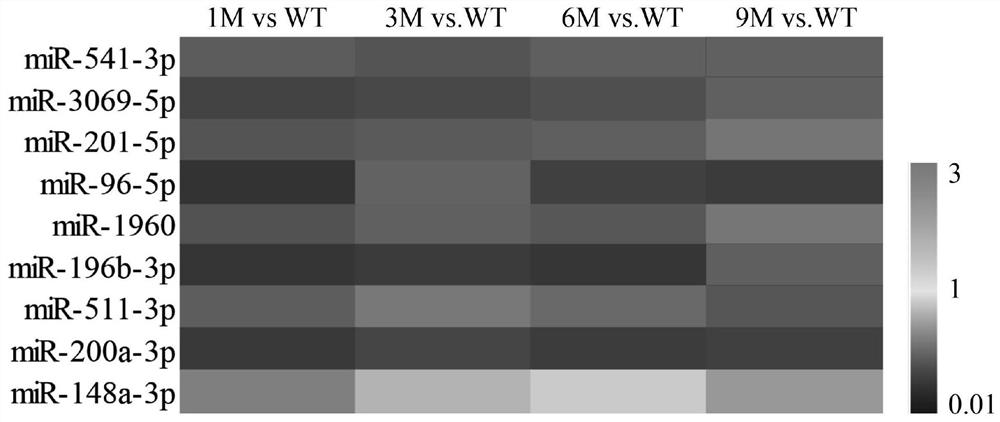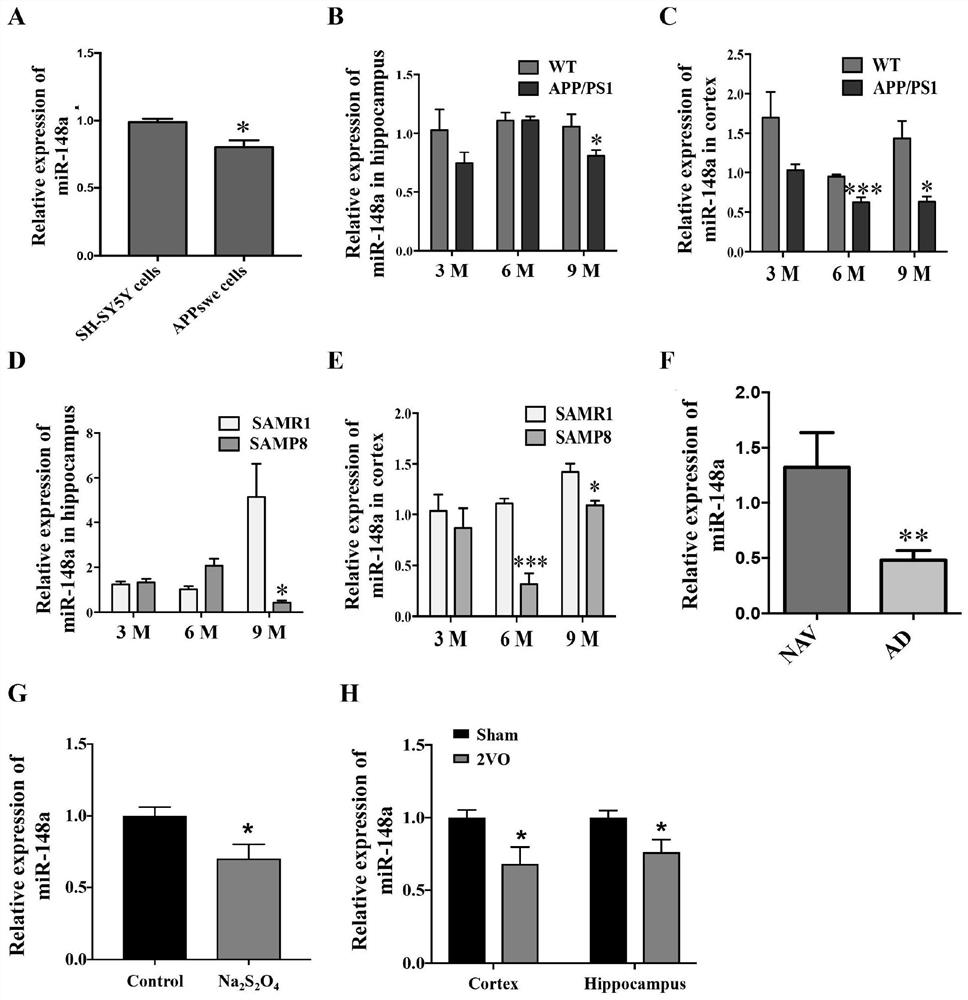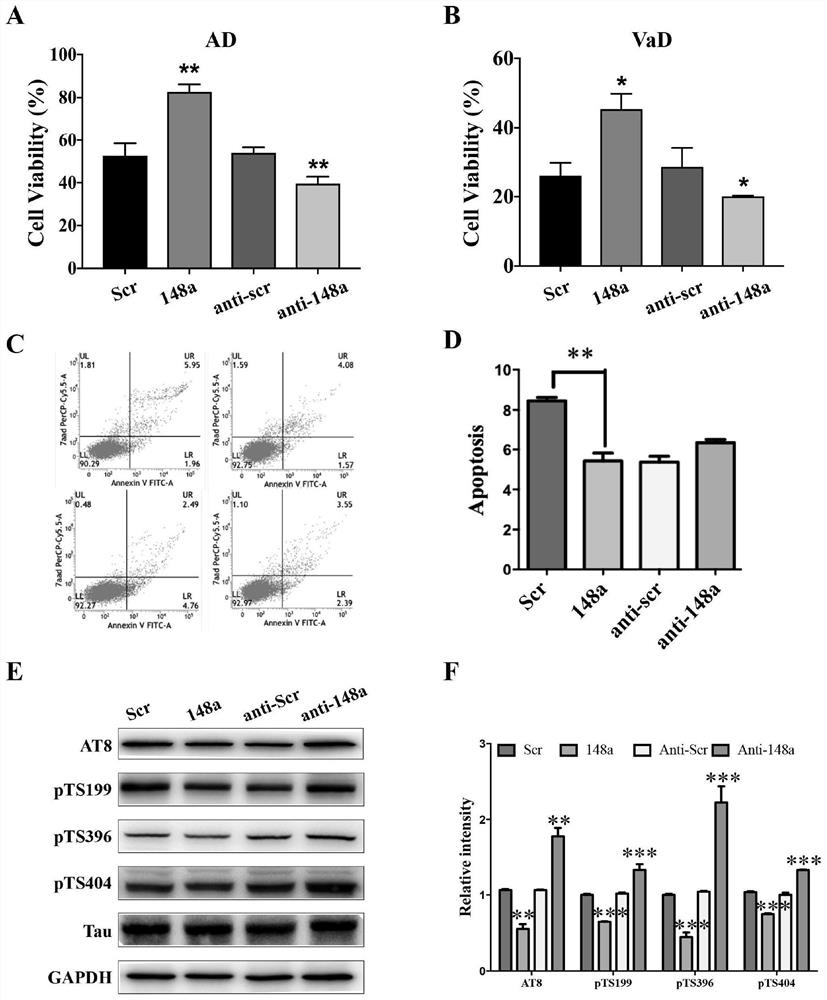Application of miRNA 148 cluster as marker for diagnosis and/or treatment of cognitive disorder related diseases
A technology for cognitive impairment and diseases, applied in DNA/RNA fragments, gene therapy, neurological diseases, etc., can solve the problems of complex pathogenesis, lack of early diagnosis and screening methods, and difficulty in disease screening and prevention.
- Summary
- Abstract
- Description
- Claims
- Application Information
AI Technical Summary
Problems solved by technology
Method used
Image
Examples
Embodiment 1
[0059] Example 1, miRNA chip technology detects the differential expression of miR-148a in the brain tissue of AD model animals and wild-type animals
[0060] RNA was extracted from the brain tissues of 1, 3, 6, and 9-month-old APP / PS1 double transgenic mice and their wild-type control mice, and miRCURY was used to TM Array Power Labeling kit fluorescently labels miRNA. The microRNA of the miRNA 148 cluster of the present invention is hsa-miR-148a, and its sequence is shown in SEQ ID NO.1: gaggcaaagu ucugagacacuccgacucug aguaugauag aagucagugc acuacagaac uuugucuc. Its default mature body (hsa-miR-148a-3p) sequence is shown in SEQ ID NO.2: ucagugcacuacagaacuuugu. Among them, mature (hsa-miR-148a-3p) miRNA reverse transcription primer: SEQ ID NO.3: gtcgtatcca gtgcagggtc cgaggtattcgcactggata cgacacaaag; qPCR forward primer: SEQ ID NO.4: gcgcgtcagt gcactacagaa; reverse primer: SEQ ID NO .5: agtgcagggt ccgaggtatt. The samples were then compared with miRCURY TM Array chip hybri...
Embodiment 2
[0061] Example 2, expression changes of miR-148a in AD model cells
[0062] The Swedish-type mutant APP gene was stably transfected into SH-SY5Y cells to construct a stably transfected APPswe cell line. In the present invention, 300 μM copper ions are used to damage APPswe cells to establish an AD cell model, and cell RNA is extracted to detect the expression level of miR-148a. Such as figure 2 As shown in middle A, compared with the normal control SH-SY5Y cells, the expression of miR-148a in AD model cells was significantly down-regulated (mean±SEM, n=3, *P<0.05).
Embodiment 3
[0063] Example 3, the expression changes of miR-148a in AD model animals and natural aging animals
[0064] The expression levels of miR-148a in the brains of APP / PS1 double transgenic mice and their wild-type (WT) control mice, SAMP8 mice and their control mice (SAMR1) were detected by qPCR. Such as figure 2 As shown in middle B-C, in the cortex and hippocampus of 3, 6, and 9-month-old APP / PS1 mice, the expression level of miR-148a showed a downward trend, and the 6- and 9-month-old APP / PS1 mice There were statistical differences compared with mice (mean±SEM, n=4, *P figure 2 As shown in D-E, in the hippocampus of SAMP8 mice, only the expression level of miR-148a in the hippocampus of 9-month-old mice was significantly lower than that of SAMR1 controls at the same age (mean±SEM, n=4, *P<0.05); In the cortex, the miR-148a expression levels of 6- and 9-month-old SAMP8 mice were significantly lower than those of SAMR1 control mice (mean±SEM, n=4, *P<0.05, ***P<0.001). It was ...
PUM
 Login to View More
Login to View More Abstract
Description
Claims
Application Information
 Login to View More
Login to View More - R&D
- Intellectual Property
- Life Sciences
- Materials
- Tech Scout
- Unparalleled Data Quality
- Higher Quality Content
- 60% Fewer Hallucinations
Browse by: Latest US Patents, China's latest patents, Technical Efficacy Thesaurus, Application Domain, Technology Topic, Popular Technical Reports.
© 2025 PatSnap. All rights reserved.Legal|Privacy policy|Modern Slavery Act Transparency Statement|Sitemap|About US| Contact US: help@patsnap.com



